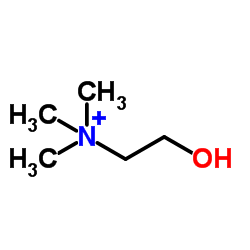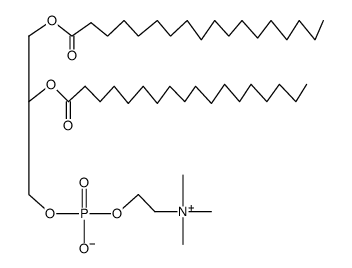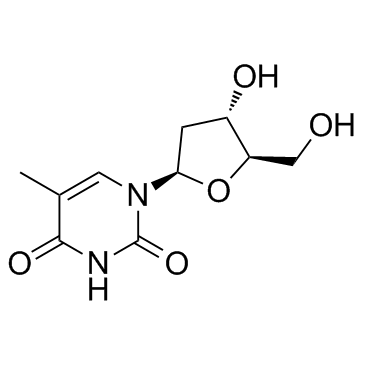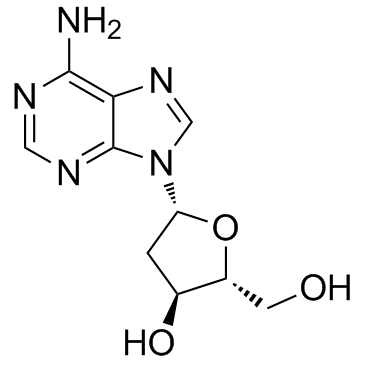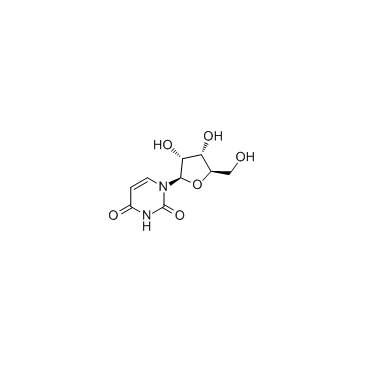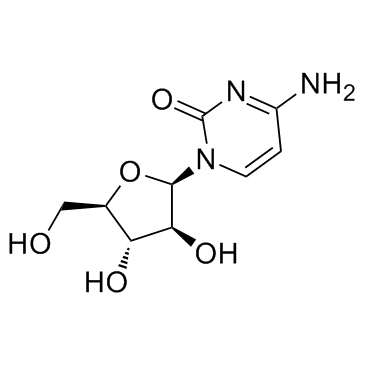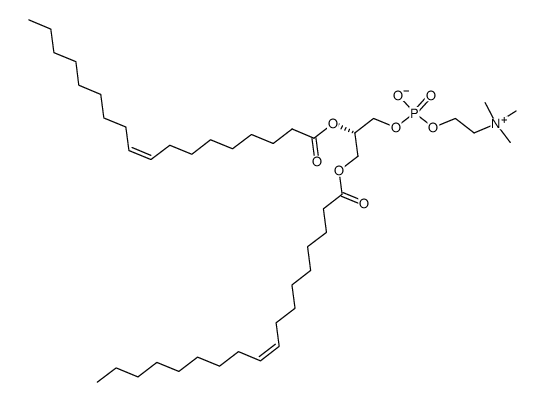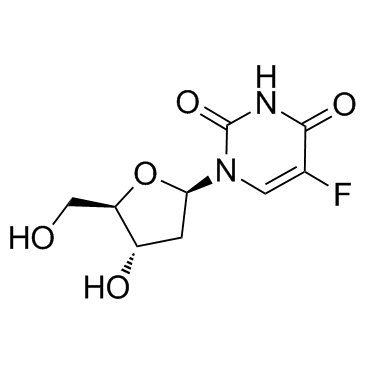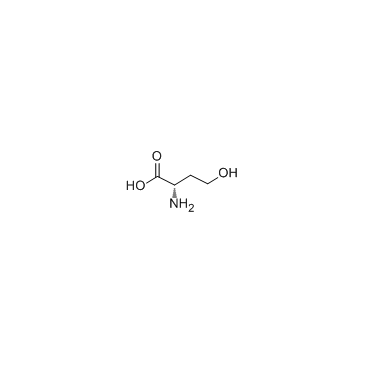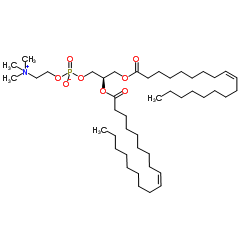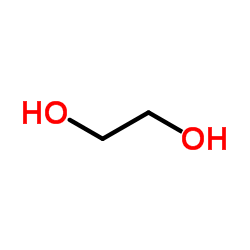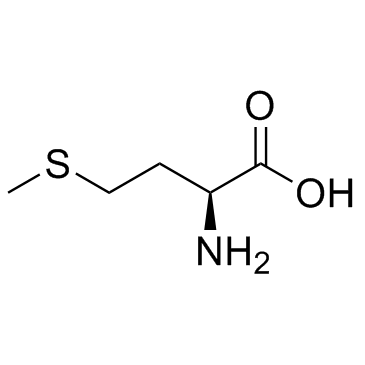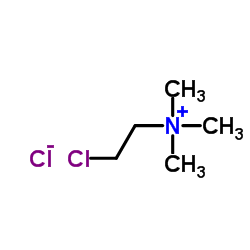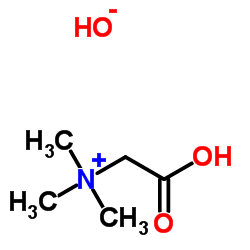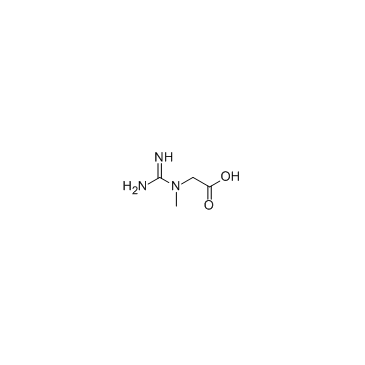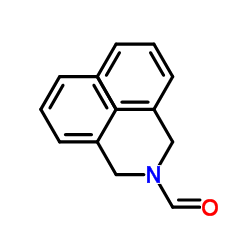62-49-7
| Name | choline |
|---|---|
| Synonyms |
2-hydroxy-N,N,N-trimethyl-Ethanaminium
CholineBitartrateFcc (2-Hydroxyethyl)trimethyl ammonium [3H]-Choline (2-hydroxyethyl)trimethylammonium (β-hydroxyethyl)trimethylammonium choline ChlolineBitartarate cholinecation (b-Hydroxyethyl)trimethylammonium Ethanaminium, 2-hydroxy-N,N,N-trimethyl- MFCD00272239 2-Hydroxy-N,N,N-trimethylethanaminium Choline Base Aqueous bilineurine EINECS 204-625-1 Choline (8CI) Sincalin |
| Density | 1.09 g/mL at 20 °C |
|---|---|
| Molecular Formula | C5H14NO |
| Molecular Weight | 104.170 |
| Exact Mass | 104.106987 |
| PSA | 20.23000 |
| LogP | -3.70 |
| Index of Refraction | n20/D 1.418 |
| Storage condition | 2-8°C |
Synonym: Section 2 - COMPOSITION, INFORMATION ON INGREDIENTS
Risk Phrases: 11 34 Section 3 - HAZARDS IDENTIFICATION EMERGENCY OVERVIEW
Highly flammable. Causes burns. Potential Health Effects Eye: Vapors may cause eye irritation. May cause painful sensitization to light. May cause severe eye irritation and possible injury. Skin: May cause skin irritation. May be absorbed through the skin. Ingestion: May be fatal or cause blindness if swallowed. May cause irritation of the digestive tract. May cause kidney damage. May cause systemic toxicity with acidosis. May cause central nervous system depression, characterized by excitement, followed by headache, dizziness, drowsiness, and nausea. Advanced stages may cause collapse, unconsciousness, coma and possible death due to respiratory failure. Inhalation: Inhalation of high concentrations may cause central nervous system effects characterized by nausea, headache, dizziness, unconsciousness and coma. May cause respiratory tract irritation. May cause visual impairment and possible permanent blindness. May cause effects similar to those described for ingestion. Vapors may cause dizziness or suffocation. Chronic: Chronic inhalation and ingestion may cause effects similar to those of acute inhalation and ingestion. Section 4 - FIRST AID MEASURES Eyes: Flush eyes with plenty of water for at least 15 minutes, occasionally lifting the upper and lower eyelids. Get medical aid immediately. Skin: Get medical aid. Immediately flush skin with plenty of water for at least 15 minutes while removing contaminated clothing and shoes. Wash clothing before reuse. Ingestion: Call a poison control center. If swallowed, do not induce vomiting unless directed to do so by medical personnel. Never give anything by mouth to an unconscious person. Get medical aid. Inhalation: Remove from exposure and move to fresh air immediately. If not breathing, give artificial respiration. If breathing is difficult, give oxygen. Get medical aid. Notes to Physician: Section 5 - FIRE FIGHTING MEASURES General Information: As in any fire, wear a self-contained breathing apparatus in pressure-demand, MSHA/NIOSH (approved or equivalent), and full protective gear. Vapors may form an explosive mixture with air. Use water spray to keep fire-exposed containers cool. Extremely flammable liquid and vapor. Containers may explode in the heat of a fire. Will be easily ignited by heat, sparks or flame. Extinguishing Media: For small fires, use dry chemical, carbon dioxide, water spray or alcohol-resistant foam. For large fires, use water spray, fog, or alcohol-resistant foam. Use water spray to cool fire-exposed containers. Water may be ineffective. Do NOT use straight streams of water. Section 6 - ACCIDENTAL RELEASE MEASURES General Information: Use proper personal protective equipment as indicated in Section 8. Spills/Leaks: Absorb spill with inert material (e.g. vermiculite, sand or earth), then place in suitable container. Remove all sources of ignition. Provide ventilation. A vapor suppressing foam may be used to reduce vapors. Water spray may reduce vapor but may not prevent ignition in closed spaces. Section 7 - HANDLING and STORAGE Handling: Wash thoroughly after handling. Ground and bond containers when transferring material. Avoid contact with eyes, skin, and clothing. Empty containers retain product residue, (liquid and/or vapor), and can be dangerous. Keep container tightly closed. Keep away from heat, sparks and flame. Avoid ingestion and inhalation. Use only in a chemical fume hood. Do not pressurize, cut, weld, braze, solder, drill, grind, or expose empty containers to heat, sparks or open flames. Storage: Keep away from heat, sparks, and flame. Keep away from sources of ignition. Do not store in direct sunlight. Store in a tightly closed container. Store in a cool, dry, well-ventilated area away from incompatible substances. Section 8 - EXPOSURE CONTROLS, PERSONAL PROTECTION Engineering Controls: Facilities storing or utilizing this material should be equipped with an eyewash facility and a safety shower. Use adequate ventilation to keep airborne concentrations low. Use only under a chemical fume hood. Exposure Limits CAS# 62-49-7: CAS# 67-56-1: United Kingdom, WEL - TWA: 200 ppm TWA; 266 mg/m3 TWA United Kingdom, WEL - STEL: 250 ppm STEL; 333 mg/m3 STEL United States OSHA: 200 ppm TWA; 260 mg/m3 TWA Belgium - TWA: 200 ppm VLE; 266 mg/m3 VLE Belgium - STEL: 250 ppm VLE; 333 mg/m3 VLE France - VME: 200 ppm VME; 260 mg/m3 VME France - VLE: 1000 ppm VLE; 1300 mg/m3 VLE Germany: 200 ppm TWA; 270 mg/m3 TWA Germany: Skin absorber Japan: 200 ppm OEL; 260 mg/m3 OEL Malaysia: 200 ppm TWA; 262 mg/m3 TWA Netherlands: 200 ppm MAC; 260 mg/m3 MAC Russia: 5 mg/m3 TWA Spain: 200 ppm VLA-ED; 266 mg/m3 VLA-ED Spain: 250 ppm VLA-EC; 333 mg/m3 VLA-EC Personal Protective Equipment Eyes: Wear appropriate protective eyeglasses or chemical safety goggles as described by OSHA's eye and face protection regulations in 29 CFR 1910.133 or European Standard EN166. Skin: Wear appropriate protective gloves to prevent skin exposure. Clothing: Wear appropriate protective clothing to prevent skin exposure. Respirators: Follow the OSHA respirator regulations found in 29 CFR 1910.134 or European Standard EN 149. Use a NIOSH/MSHA or European Standard EN 149 approved respirator if exposure limits are exceeded or if irritation or other symptoms are experienced. Section 9 - PHYSICAL AND CHEMICAL PROPERTIES Physical State: Liquid Color: clear colorless to almost colorless Odor: Amine-like odor pH: Not available. Vapor Pressure: Not available. Viscosity: Not available. Boiling Point: 113 deg C @ 760.00mm Hg Freezing/Melting Point: Not available. Autoignition Temperature: 349 deg C ( 660.20 deg F) Flash Point: -33 deg C ( -27.40 deg F) Explosion Limits, lower: N/A Explosion Limits, upper: N/A Decomposition Temperature: Solubility in water: soluble Specific Gravity/Density: .9400g/cm3 Molecular Formula: Not applicable. Molecular Weight: Section 10 - STABILITY AND REACTIVITY Chemical Stability: Stable under normal temperatures and pressures. Conditions to Avoid: Incompatible materials, light, ignition sources, exposure to air, excess heat. Incompatibilities with Other Materials: Acids (mineral, non-oxidizing, e.g. hydrochloric acid, hydrofluoric acid, muriatic acid, phosphoric acid), acids (mineral, oxidizing, e.g. chromic acid, hypochlorous acid, nitric acid, sulfuric acid), acids (organic, e.g. acetic acid, benzoic acid, formic acid, methanoic acid, oxalic acid), azo, diazo, and hydrazines (e.g. dimethyl hydrazine, hydrazine, methyl hydrazine), isocyanates (e.g. methyl isocyanate), metals (alkali and alkaline, e.g. cesium, potassium, sodium), nitrides (e.g. potassium nitride, sodium nitride), peroxides and hydroperoxides (organic, e.g. acetyl peroxide, benzoyl peroxide, butyl peroxide, methyl ethyl ketone peroxide), epoxides (e.g. butyl glycidyl ether), oxidizing agents (strong, e.g. bromine, hydrogen peroxide, nitrogen dioxide, potassium nitrate), reducing agents (strong, e.g. aluminum carbide, chlorosilane, hydrogen phosphide, lithium hydride), water reactive substances (e.g. acetic anyhdride, alkyl aluminum chloride, calcium carbide, ethyl dichlorosilane). Hazardous Decomposition Products: Nitrogen oxides, carbon monoxide, carbon dioxide. Hazardous Polymerization: Will not occur. Section 11 - TOXICOLOGICAL INFORMATION RTECS#: CAS# 62-49-7: FZ9625000 CAS# 67-56-1: PC1400000 LD50/LC50: Not available. CAS# 67-56-1: Draize test, rabbit, eye: 40 mg Moderate; Draize test, rabbit, eye: 100 mg/24H Moderate; Draize test, rabbit, skin: 20 mg/24H Moderate; Inhalation, rabbit: LC50 = 81000 mg/m3/14H; Inhalation, rat: LC50 = 64000 ppm/4H; Oral, mouse: LD50 = 7300 mg/kg; Oral, rabbit: LD50 = 14200 mg/kg; Oral, rat: LD50 = 5600 mg/kg; Skin, rabbit: LD50 = 15800 mg/kg. Carcinogenicity: Choline - Not listed by ACGIH, IARC, or NTP. Methyl alcohol - Not listed by ACGIH, IARC, or NTP. Other: See actual entry in RTECS for complete information. Section 12 - ECOLOGICAL INFORMATION Section 13 - DISPOSAL CONSIDERATIONS Dispose of in a manner consistent with federal, state, and local regulations. Section 14 - TRANSPORT INFORMATION IATA Shipping Name: FLAMMABLE LIQUID, CORROSIVE, N.O.S.* Hazard Class: 3 (8) UN Number: 2924 Packing Group: II IMO Shipping Name: FLAMMABLE LIQUID, CORROSIVE, N.O.S. Hazard Class: 3.2 (8) UN Number: 2924 Packing Group: II RID/ADR Shipping Name: FLAMMABLE LIQUID, CORROSIVE, N.O.S. Hazard Class: 3 UN Number: 2924 Packing group: II USA RQ: CAS# 67-56-1: 5000 lb final RQ; 2270 kg final RQ Section 15 - REGULATORY INFORMATION European/International Regulations European Labeling in Accordance with EC Directives Hazard Symbols: T F Risk Phrases: R 11 Highly flammable. R 34 Causes burns. Safety Phrases: S 16 Keep away from sources of ignition - No smoking. S 28A After contact with skin, wash immediately with plenty of water. S 33 Take precautionary measures against static discharges. S 36/37/39 Wear suitable protective clothing, gloves and eye/face protection. S 45 In case of accident or if you feel unwell, seek medical advice immediately (show the label where possible). WGK (Water Danger/Protection) CAS# 62-49-7: No information available. CAS# 67-56-1: 1 Canada CAS# 62-49-7 is listed on Canada's DSL List. CAS# 67-56-1 is listed on Canada's DSL List. CAS# 62-49-7 is not listed on Canada's Ingredient Disclosure List. CAS# 67-56-1 is listed on Canada's Ingredient Disclosure List. US FEDERAL TSCA CAS# 62-49-7 is listed on the TSCA inventory. CAS# 67-56-1 is listed on the TSCA inventory. SECTION 16 - ADDITIONAL INFORMATION N/A |
CHEMICAL IDENTIFICATION
HEALTH HAZARD DATAACUTE TOXICITY DATA
|
| Hazard Codes | C: Corrosive; |
|---|---|
| Risk Phrases | 34 |
| Safety Phrases | S26-S36/37/39-S45 |
| RIDADR | UN 3286 3/PG 2 |
| WGK Germany | 1 |
| Packaging Group | II |
| Hazard Class | 8 |
| Precursor 10 | |
|---|---|
| DownStream 10 | |
